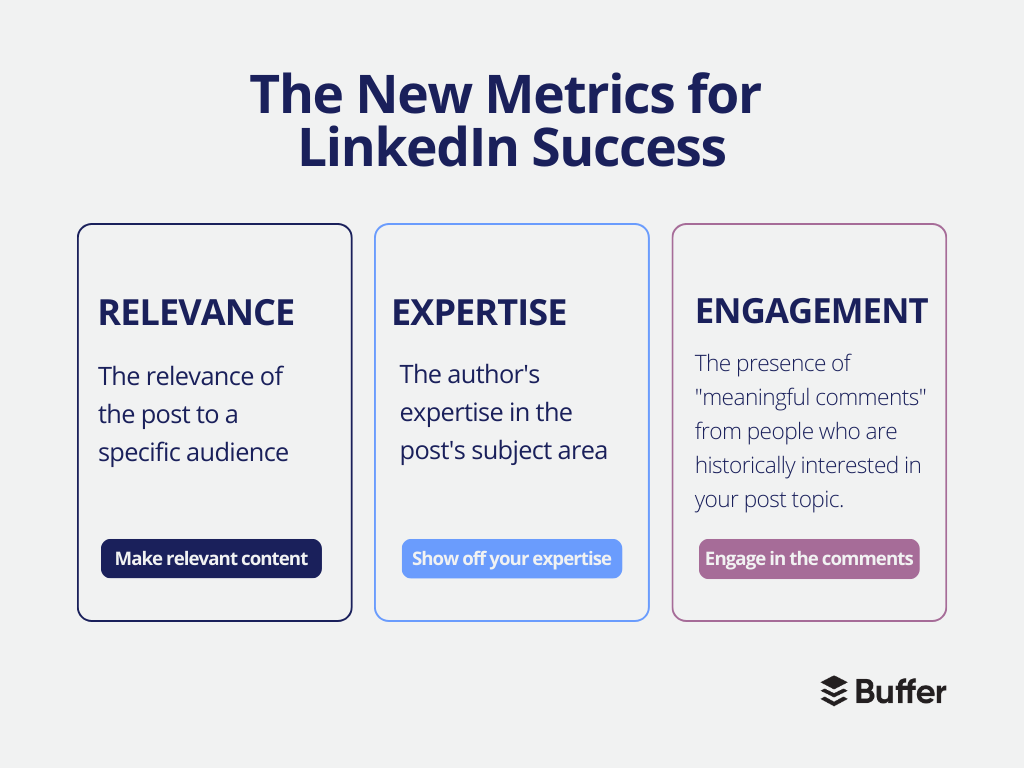

Close


LinkedIn’s algorithm has always been a bit of a mystery – until now. The algorithm recently underwent some key changes, and the team (through Dan Roth, editor-in-chief, and Alice Xiong, a product management director) sat down with Entrepreneur to explain them.
In this article, we’ll highlight the key points from the team’s interview about the LinkedIn algorithm and share practical tips for applying this knowledge to your content.
Unlike YouTube and Instagram, LinkedIn feeds you content primarily from one place – your Feed. When you type in the LinkedIn URL, this is the landing page, so it’s your first impression of all the content on the platform.
With over 900 million members and the number of daily posts in the millions, if not billions, there’s no way around it: relevant content is key.
The promise of the algorithm is that if you create content relevant to a specific audience, they will see your content. The reverse is true for audiences: what they engage with is what they’ll see.
If you always engage with marketing-related content, you’ll see more of that on your Feed. If you always post about marketing, your target audience will inevitably see more of your content. And the more niche your approach is, the better the algorithm can direct your content to the top of the right Feeds.
With this context in mind, all the updates are in service of getting the right content in front of the right audience.
Before, LinkedIn’s algorithm amplified the most engaging (viral) content. When work and personal lives merged a few years ago, the platform saw an influx of personal content reminiscent of what you’d see on Facebook.
With the change in posting style, membership and engagement grew, but also caused a lot of irrelevant content to float to the top of users’ Feeds. So with the algorithm updates, viral content is more likely to hurt your visibility and engagement than help it, as it might start hitting Feeds where it isn’t relevant, so not getting much engagement beyond reactions.
This is a user-requested update, as most people find the content from their existing network the most valuable. This also means that the quality of your network is more important than ever – if you want engagement, the people you connect with need to see value in your content.
LinkedIn’s updated algorithm rewards knowledge-rich posts by extending their reach beyond its immediate network. This indicates that even non-connected users who might find your content useful could see your posts.
The platform is looking to highlight more knowledge and advice experts share. For users, the algorithm determines what expertise is relevant by identifying a user’s interests based on their profile info and activity.
For creators, it looks at the level of engagement and shares your content receives as a signal that you’re making something people want to see. Comments, especially in-depth replies, and continuing conversations, also help to improve your placement in the algorithm. Take advantage of LinkedIn’s features, like carousels or in-Feed videos, to add more detail to your posts.
The new LinkedIn system uses certain metrics to evaluate content: Relevance, Expertise, and Engagement.

As a creator, you should aim to design content that not only appeals to a specific audience but also underscores your expertise and encourages genuine engagement. Here’s how.
You need to start treating LinkedIn like you would a work conference. You’re there to:
So your presentation should:
LinkedIn wants to: serve the right content to the right audience, which means categorizing content better. With this in mind, your posts will be categorized better if they:
More broadly, when creating these posts, you should:
Finally, the more you share, the better LinkedIn will theoretically understand who you are, what you do, and who wants to see your posts, so publish frequently.
The updates to LinkedIn’s algorithm mean great things for creators with niche interests and expertise but aren’t sure how they’ll be received by a general audience. You don’t need to try to beat it or game it – just go with its flow.
Since the algorithm cares more about getting your content in front of the right people, you can be assured that you’ll grow as long as you optimize your posts and keep up your engagement through comments and replies.
In other great news, scheduling content isn’t penalized – only abandoning your scheduled content. So get a head start on drafting a bunch of new, relevant content for your audience on LinkedIn through Buffer.

